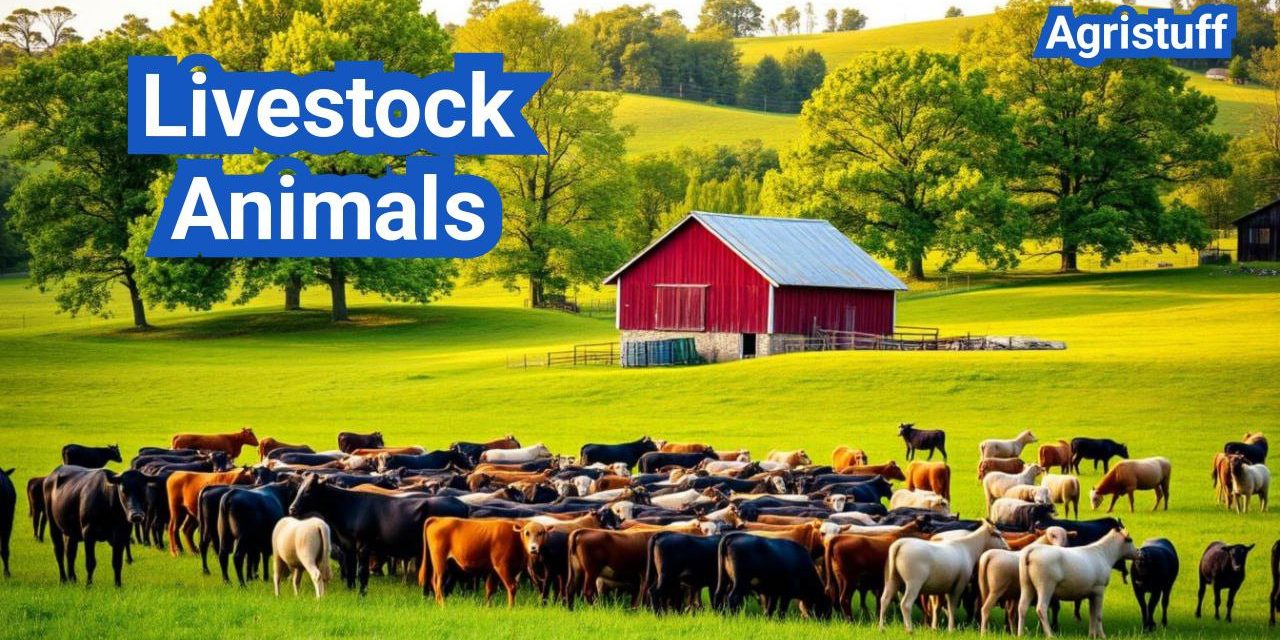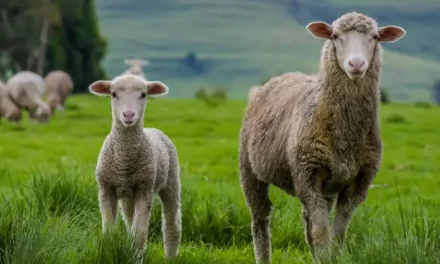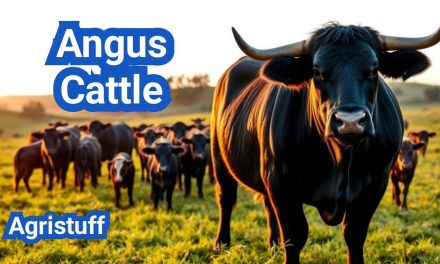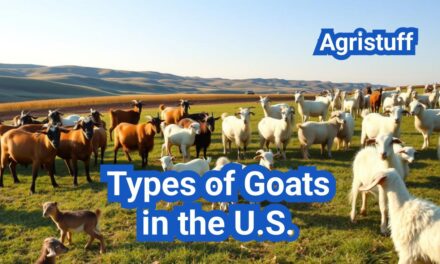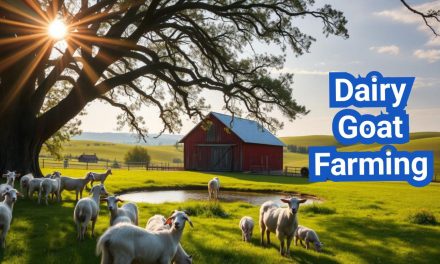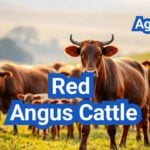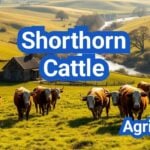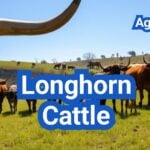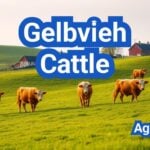Livestock animals play a vital role in agriculture, providing labor and a variety of products for consumption.
The importance of livestock farming cannot be overstated, as it contributes significantly to the economy and food security.
Various types of livestock animals are raised for different purposes, including cattle for meat and dairy, poultry for eggs and meat, and sheep for wool and meat.
Understanding the different livestock animal breeds and their uses is crucial for effective livestock management and sustainable practices.
Key Takeaways
- Understanding the role of livestock in agriculture.
- Recognizing the different types of livestock animals.
- Learning about various livestock animal breeds.
- The importance of sustainable livestock practices.
- The economic impact of livestock farming.
What Are Livestock Animals and Their Importance
Understanding livestock animals is crucial for appreciating their role in food security and the economy. Livestock animals are domesticated creatures raised on farms or ranches for various products such as meat, dairy, wool, and more.
Definition and Economic Significance
Livestock animals are defined as domesticated animals raised for labor, meat, milk, or other products. They play a vital role in the global economy, contributing significantly to the agricultural sector. The economic significance of livestock is multifaceted, providing employment opportunities, generating income for farmers, and contributing to the GDP of countries.
“Livestock production is a critical component of agriculture, supporting the livelihoods of millions of people worldwide,” as emphasized by agricultural experts. The industry’s economic impact is substantial, with the global livestock market projected to continue growing in response to increasing demand for animal products.
Historical Role in Agriculture | Livestock Animals
Historically, livestock animals have been integral to agriculture, serving as a source of power for plowing fields, transportation, and manure for fertilizer. Over time, their role has evolved, with advancements in technology and breeding practices enhancing their productivity and the quality of products derived from them.
The historical significance of livestock in agriculture cannot be overstated. They have been crucial in the development of settled agriculture, enabling the growth of crops and the support of larger human populations. As agriculture has modernized, the role of livestock has adapted, incorporating new practices and technologies.
Modern Importance in Food Security | Livestock Animals
In modern times, livestock animals remain essential for global food security. They provide a significant portion of the world’s protein through meat, dairy, and eggs. The importance of livestock in food security is particularly pronounced in developing countries, where they are a vital source of nutrition and income.
Livestock management practices are critical in ensuring the health and productivity of these animals. Effective livestock inspection and health management are key to preventing disease outbreaks and maintaining the overall health of livestock populations.
The future of livestock farming will likely involve continued innovation in breeding, nutrition, and health management to meet the challenges of food security, environmental sustainability, and climate change.
Types of Livestock Animals

Cattle, sheep, goats, and pigs are among the most common types of livestock animals, contributing significantly to agriculture and human sustenance. These animals are raised for various purposes, including meat, dairy, wool, and labor.
Cattle
Cattle are one of the most versatile livestock animals, providing meat, dairy, and labor. Beef and dairy cattle are the most common categories, with various breeds suited to different farming systems.
“Cattle are a crucial part of agriculture, not just for their products but also for their role in maintaining land health through grazing,” says an agricultural expert.
Sheep
Sheep are valued for their wool, meat, and milk. Different breeds are specialized for these purposes, with some serving multiple roles.
Sheep farming is a significant industry worldwide, with various breeds adapted to different climates and farming practices.
Goats
Goats are known for their adaptability and are raised for milk, meat, and fiber. They are particularly useful in challenging terrains where other livestock might struggle.
Goat farming is gaining popularity due to the increasing demand for goat milk and meat products.
Pigs
Pigs are primarily raised for meat and are a significant part of many agricultural economies. Pig farming involves various breeds and production systems, ranging from intensive to extensive.
The efficiency of pig farming, in terms of feed conversion and growth rate, makes pigs an important livestock animal globally.
Popular Cattle Breeds
Cattle breeds are diverse, catering to various agricultural needs, from beef production to dairy farming. This diversity allows farmers to choose breeds that best suit their farming goals and environmental conditions.
Beef Cattle Breeds
Beef cattle breeds are raised specifically for meat production. Some of the most renowned breeds include:
- Angus: Known for their high-quality beef, Angus cattle are a popular choice among beef farmers.
- Brahman: Originating from India, Brahman cattle are heat-tolerant and often used in tropical regions.
Dairy Cattle Breeds
Dairy cattle breeds are specialized for milk production. Notable breeds include:
- Holstein Friesian: One of the most common dairy breeds, Holsteins are prized for their high milk yield.
- Jersey: Jersey cattle are known for their rich milk, which is ideal for cheese production.
Miniature and Specialty Cattle
Miniature and specialty cattle are gaining popularity for their unique characteristics and lower maintenance requirements. Examples include:
- Miniature Hereford: A smaller version of the traditional Hereford, these cattle are ideal for small farms.
- Dexter: Known for their versatility, Dexter cattle are used for both milk and meat production.
The following table summarizes the characteristics of some popular cattle breeds:
| Breed | Type | Primary Use |
|---|---|---|
| Angus | Beef | Meat Production |
| Holstein Friesian | Dairy | Milk Production |
| Brahman | Beef | Meat Production |
| Jersey | Dairy | Milk Production |
Essential Sheep Breeds

The world of sheep is vast, with numerous breeds that cater to different agricultural needs. Sheep breeds are categorized based on their primary use, such as wool production, meat production, or dual-purpose, making them versatile for various farming objectives.
Wool-Producing Sheep
Wool-producing sheep are bred specifically for their high-quality fleece. The Merino sheep is one of the most renowned breeds in this category, known for its fine wool that is highly prized for its softness and warmth.
Other notable wool-producing breeds include the Rambouillet and the Shetland sheep. These breeds are often raised in regions with suitable climates for wool production.
Meat-Producing Sheep
Meat-producing sheep are raised for their meat, which is consumed globally in various forms. The Dorper sheep is a popular breed in this category, appreciated for its fast growth rate and high-quality meat.
Other breeds like the Suffolk and Hampshire are also widely used for meat production due to their muscular build and efficient feed conversion.
Dual-Purpose Sheep
Dual-purpose sheep breeds are valued for both their wool and meat. These breeds offer farmers a versatile option, allowing them to benefit from multiple revenue streams.
Examples of dual-purpose breeds include the Columbia and the Corriedale. These sheep are known for their robust health and productivity.
Specialty Sheep
Specialty sheep breeds are often raised for unique characteristics or products, such as milk or specific types of wool. The East Friesian sheep, for instance, is known for its high milk production, making it ideal for dairy farming.
| Breed | Primary Use | Notable Characteristics |
|---|---|---|
| Merino | Wool Production | Fine wool, softness, warmth |
| Dorper | Meat Production | Fast growth rate, high-quality meat |
| Columbia | Dual-Purpose | Robust health, wool, and meat |
As noted by agricultural experts, “The diversity in sheep breeds allows farmers to choose the most suitable animals for their specific needs, enhancing productivity and sustainability in livestock farming.”
“Sheep farming is not just about raising animals; it’s about preserving traditions and contributing to local economies.”
Agricultural Journal
Notable Goat Breeds
Notable goat breeds have been developed for specific purposes, including dairy, meat, and fiber production. These breeds are crucial for various agricultural practices and are selected based on their productivity and adaptability.
Dairy Goats
Dairy goats are bred specifically for their milk production. Breeds like LaMancha and Saanen are renowned for their high milk yield and are often used in dairy farming. Dairy goat breeds are known for their ability to produce high-quality milk, which is used to make cheese, butter, and other dairy products.
“The LaMancha goat, known for its distinctive earless or very short-eared appearance, is a popular choice for dairy farming due to its high milk production capabilities.”
Meat Goats
Meat goat breeds are raised for their meat and are a vital part of many agricultural economies. The Boer goat is one of the most well-known meat goat breeds, originating from South Africa. Boer goats are prized for their fast growth rate and high-quality meat.
- Boer goats are known for their muscular build and are often used in crossbreeding programs to improve meat production.
- Other notable meat goat breeds include the Kiko and the Spanish goat.
Fiber-Producing Goats
Fiber-producing goats, such as the Angora goat, are valued for their mohair or angora fiber. These fibers are used to produce high-quality textiles, including clothing and carpets. Angora goats are known for their soft, curly coats, which require regular grooming.
The angora fiber produced by these goats is highly prized for its softness and warmth, making it a valuable commodity in the textile industry.
Miniature Goats
Miniature goats, like the Nigerian Dwarf, are popular as pets or for small-scale dairy production. Despite their small size, Nigerian Dwarfs are known for their high milk production relative to their body size and are friendly, making them a great choice for hobbyists.
“Nigerian Dwarfs are not only productive but also have a gentle disposition, making them suitable for a variety of farming or hobbyist settings.”
Livestock Animal Uses and Products

From food production to labor, livestock animals play a crucial role in sustaining human life and communities. Livestock animals provide a range of products and services that are essential for human well-being and economic stability.
Food Production
Livestock animals are a primary source of food globally, providing meat, dairy, and eggs. Meat production involves raising animals like cattle, pigs, and sheep for their flesh, which is consumed directly or processed into various products. Dairy farming focuses on milk production, mainly from cows, goats, and sheep, which is consumed as is or processed into cheese, butter, and other dairy products.
The egg production industry is dominated by chickens, with some farms specializing in duck and quail eggs. These food products are not only vital for nutrition but also contribute significantly to the economy through trade and employment.
Fiber and Textiles
Livestock animals are also a source of fiber used in the textile industry. Sheep are the primary source of wool, which is sheared annually and processed into clothing, carpets, and other textile products. Goats, particularly Angora goats, provide mohair and cashmere fibers that are highly valued for their softness and warmth.
Labor and Transportation
In many parts of the world, livestock animals are used for labor and transportation. Horses, donkeys, and mules are commonly used as pack animals or for plowing fields. This use of livestock is particularly important in areas where mechanized farming is not feasible due to terrain or economic constraints.
Byproducts and Other Uses
Livestock animals provide various byproducts that are used in different industries. Bones, hides, and skins are processed into glue, gelatin, and leather products. Manure from livestock is used as fertilizer, enhancing soil fertility and promoting sustainable agriculture.
Additionally, some livestock animals are used in conservation grazing, helping to manage landscapes and maintain ecological balance. The diversity of products and services derived from livestock underscores their importance in human society and the economy.
Livestock Breeding Practices

Livestock breeding practices have evolved significantly, incorporating advanced genetic techniques and selective breeding principles to enhance the quality and productivity of livestock animals. Effective breeding is crucial for improving animal health, farm profitability, and meeting the increasing demand for high-quality livestock products.
Selective Breeding Principles
Selective breeding involves choosing animals with desirable traits to breed the next generation. This method is based on the principle that the selected traits will be passed on to the offspring, thereby improving the overall quality of the livestock. Key factors considered in selective breeding include fertility, growth rate, and disease resistance.
The success of selective breeding programs depends on accurate record-keeping and the ability to identify superior genetic lines. Farmers and breeders must also balance the need for genetic improvement with the potential risks of reduced genetic diversity.
Cattle Breeding Techniques
Cattle breeding techniques have advanced with the use of modern reproductive technologies such as artificial insemination (AI) and embryo transfer (ET). AI allows for the widespread use of superior sires, improving the genetic quality of cattle herds. ET further enhances this by enabling the production of multiple offspring from a single, high-quality female.
Other techniques, such as genomic selection, are also being adopted to improve breeding efficiency and accuracy. Genomic selection involves using DNA testing to identify genetic markers associated with desirable traits, enabling breeders to make more informed decisions.
Sheep and Goat Breeding
Sheep and goat breeding programs focus on improving traits such as wool production, meat quality, and milk production. Breeding strategies for these animals often involve crossbreeding to combine the strengths of different breeds.
For instance, wool-producing sheep breeds are often crossed with meat-producing breeds to create dual-purpose animals. Similarly, dairy goat breeds are selected for their milk production capabilities, with breeding programs aimed at enhancing lactation performance and overall health.
Genetic Considerations
Genetic considerations are paramount in livestock breeding. Breeders must consider the genetic diversity of their animals to avoid inbreeding, which can lead to reduced fertility and increased susceptibility to disease. Maintaining a diverse gene pool is essential for the long-term sustainability of breeding programs.
Additionally, breeders are increasingly focusing on genetic traits that enhance animal welfare and environmental sustainability. This includes selecting for animals that are more resilient to disease and better adapted to their production environments.
Livestock Farming Systems
Livestock farming systems can be broadly categorized into several types, each with its own set of advantages and challenges. These systems vary significantly in their practices, impact on the environment, and treatment of animals.
Intensive Farming
Intensive animal farming is characterized by high-density animal production, often in confined spaces. This method aims to maximize output while minimizing costs. Key features include controlled environments and efficient feeding systems.
While intensive farming can be efficient, it raises concerns about animal welfare and environmental impact. Proponents argue that it can reduce the overall footprint of livestock production by concentrating resources.
Extensive Farming
Extensive farming, on the other hand, involves raising livestock over larger areas, allowing animals to roam more freely. This system is often associated with grazing and can be more aligned with natural animal behaviors.
Extensive farming can promote better animal welfare and potentially lower environmental impacts per animal. However, it may require more land and can be less efficient in terms of production costs.
Mixed Farming
Mixed farming combines livestock production with crop cultivation. This integrated approach can enhance farm resilience and biodiversity. Mixed farms can benefit from the synergies between livestock and crops, such as using manure as fertilizer.
This system allows for a more diverse range of products and can be more sustainable by reducing waste and promoting ecological balance.
Organic Livestock Farming
Organic livestock farming adheres to strict standards that prohibit the use of synthetic fertilizers, pesticides, and genetically modified organisms (GMOs). This approach prioritizes natural processes and animal welfare.
Organic farming is seen as a more sustainable option, with benefits for the environment and potentially for animal health. However, it can be more challenging to maintain high productivity levels.
In conclusion, the choice of livestock farming system depends on various factors, including environmental considerations, animal welfare, and economic viability. Understanding these different systems is crucial for making informed decisions in livestock production.
Essential Livestock Animal Nutrition

Understanding the nutritional needs of livestock is crucial for their overall health and productivity. Livestock nutrition involves providing the necessary nutrients for growth, maintenance, and production, whether it’s for meat, milk, or fiber.
Basic Nutritional Requirements
Livestock animals require a balanced diet that includes carbohydrates, proteins, fats, vitamins, and minerals. Carbohydrates are a primary source of energy, while proteins are essential for growth and repair. The quality and quantity of these nutrients can significantly impact the health and productivity of the animals.
- Carbohydrates: Provide energy for daily activities and growth.
- Proteins: Essential for muscle development and repair.
- Fats: Serve as a concentrated energy source and aid in the absorption of vitamins.
- Vitamins and Minerals: Crucial for various bodily functions, including immune response and overall health.
Feed Types and Quality
The type and quality of feed are critical factors in livestock nutrition. Feed can be categorized into various types, including grains, hay, silage, and concentrates. Each type has its nutritional benefits and drawbacks.
Grains are a common energy source, while hay and silage provide fiber and nutrients. Concentrates are nutrient-rich feeds used to supplement the diet. Ensuring the quality of these feeds is vital to prevent nutritional deficiencies or excesses.
Pasture Management
Effective pasture management is crucial for maintaining the health and productivity of grazing livestock. This involves practices such as rotational grazing, which helps to maintain pasture quality and reduce the risk of overgrazing.
- Rotational Grazing: Allows pastures to rest and recover, maintaining their quality.
- Pasture Monitoring: Regularly checking the condition and quality of pastures.
- Fencing and Watering: Ensuring that pastures are well-fenced and have adequate watering systems.
Supplemental Feeding
Supplemental feeding is often necessary to ensure that livestock receive a balanced diet, especially during periods when pasture quality or quantity is poor. Supplements can include vitamins, minerals, and other nutrients.
It’s essential to tailor supplemental feeding to the specific needs of the livestock, taking into account factors such as age, breed, and production level. Consulting with a veterinarian or nutritionist can help determine the most appropriate supplements.
Sustainable Livestock Practices

Implementing sustainable livestock practices is vital for the future of agriculture and environmental conservation. As the global demand for food continues to rise, adopting environmentally friendly methods in livestock farming becomes increasingly important.
Rotational Grazing | Livestock Animals
Rotational grazing is a practice that involves moving livestock to different areas of pasture to allow the land to recover. This method helps in maintaining soil health, reducing erosion, and promoting biodiversity.
- Improves soil fertility
- Enhances pasture quality
- Reduces the need for external feed
Water Conservation | Livestock Animals
Water conservation is critical in livestock farming, as it directly impacts the health and productivity of the animals. Implementing efficient irrigation systems and water-saving techniques can significantly reduce water usage.
Effective water conservation strategies include:
- Using drip irrigation systems
- Implementing rainwater harvesting
- Regularly maintaining water infrastructure
Waste Management
Proper waste management is essential for minimizing the environmental impact of livestock farming. This involves managing manure and other waste products in a way that prevents pollution and maintains soil health.
Best practices for waste management include:
- Composting manure
- Using manure as fertilizer
- Implementing waste recycling programs
Reducing Carbon Footprint
Reducing the carbon footprint of livestock farming is crucial for mitigating climate change. This can be achieved through various practices, including improving feed efficiency, reducing energy consumption, and promoting carbon sequestration.
Strategies for reducing carbon footprint:
- Optimizing feed production
- Using renewable energy sources
- Implementing agroforestry practices
By adopting these sustainable livestock practices, farmers can contribute to a more environmentally friendly agricultural sector while maintaining productivity and profitability.
Livestock and the Environment

The relationship between livestock farming and the environment is complex and multifaceted. Livestock farming has both positive and negative environmental impacts, requiring a balance between production and conservation.
Environmental Challenges
Livestock farming poses several environmental challenges, including deforestation, water pollution, and greenhouse gas emissions. The expansion of grazing land and feed crop production contributes to habitat loss and biodiversity decline.
Key environmental challenges include:
- Deforestation and land degradation
- Water pollution from manure and fertilizers
- Greenhouse gas emissions from livestock
Positive Environmental Impacts
Despite the challenges, livestock farming also has positive environmental impacts. Well-managed grazing can enhance soil health, promote biodiversity, and sequester carbon.
Some of the positive impacts include:
- Maintaining open spaces and landscapes
- Promoting biodiversity through grazing management
- Sequestering carbon in soils and vegetation
“Sustainable grazing practices can enhance ecosystem services, including carbon sequestration and biodiversity conservation.” –
Agricultural Expert
Balancing Production and Conservation
Balancing livestock production with environmental conservation is crucial. This involves adopting sustainable practices that minimize negative impacts while maintaining productivity.
Strategies for balancing production and conservation include:
- Rotational grazing to reduce land degradation
- Integrated livestock and crop farming to enhance ecosystem services
- Conservation agriculture to promote soil health
Climate Change Considerations
Livestock farming is both affected by and contributes to climate change. Rising temperatures and changing precipitation patterns impact livestock productivity, while greenhouse gas emissions from livestock contribute to global warming.
Addressing climate change involves:
- Reducing greenhouse gas emissions through improved manure management and feed efficiency
- Enhancing carbon sequestration through sustainable grazing practices
- Improving livestock resilience to climate change through breeding and management practices
Most Profitable Livestock for Small Farms

Small farms can significantly boost their profitability by focusing on high-value livestock breeds. The right choice of livestock, combined with effective marketing and product diversification, can lead to substantial financial gains.
High-Value Specialty Breeds
One of the key strategies for small farms is to raise high-value specialty breeds. These breeds, such as heritage cattle or rare sheep, can command higher prices due to their uniqueness and the quality of their products, such as meat, wool, or dairy.
For instance, certain breeds of goats are prized for their milk, which is used to produce artisanal cheeses. “The demand for specialty dairy products is on the rise, making dairy goats an attractive option for small farms,” notes an expert in livestock farming.
Direct-to-Consumer Marketing
Adopting direct-to-consumer marketing strategies can also enhance profitability. By selling directly to consumers, either through farm stands, farmers’ markets, or online platforms, small farms can retain a larger share of the profit margin.
This approach not only increases revenue but also helps in building a loyal customer base. As one farmer puts it, “Direct marketing allows us to tell the story of our farm and connect with our customers on a personal level.”
Value-Added Products
Creating value-added products is another effective strategy. By processing their livestock products into items like cheese, sausage, or wool crafts, small farms can significantly increase their earnings.
- Meat products: sausages, bacon, ham
- Dairy products: cheese, butter, yogurt
- Wool products: knitwear, hats, scarves
Diversification Strategies
Diversification is key to reducing risk and increasing profitability. Small farms can diversify by raising multiple types of livestock or by combining livestock farming with other agricultural activities, such as crop production or agritourism.
As an example, a farm that raises cattle can also offer farm tours or host events, providing an additional revenue stream.
Getting Started with Raising Livestock Animals

For those looking to start raising livestock, the first step involves assessing the foundational requirements. Raising livestock animals is a significant undertaking that demands careful planning and execution. It is essential to understand the various elements that contribute to a successful livestock operation.
Land Requirements
The amount of land required for raising livestock animals varies depending on the type and number of animals. Generally, a minimum of 1-2 acres is recommended for small-scale operations, but this can scale up significantly for larger farms.
Adequate land is crucial for providing pasture, space for housing, and areas for manure management. The quality of the land, including soil type and drainage, also plays a significant role in determining its suitability for livestock.
| Land Use | Minimum Land Requirement | Considerations |
|---|---|---|
| Pasture | 1 acre | Quality of forage, rotational grazing |
| Housing and Facilities | 0.5 acres | Space for barns, pens, and equipment storage |
| Manure Management | 0.25 acres | Adequate space for manure storage and disposal |
Housing and Facilities
Providing appropriate housing and facilities is critical for the health and well-being of livestock. The type of housing needed depends on the species, climate, and production system.
Key considerations include:
- Protection from the elements
- Adequate ventilation
- Space for feeding and watering
- Sanitation and hygiene facilities
Equipment Essentials
The equipment needed for raising livestock animals includes feeding and watering systems, fencing, and manure handling equipment. The specific equipment required will depend on the type and size of the operation.
Some essential equipment includes:
- Feeders and waterers
- Fencing materials
- Tractors and loaders
- Manure spreaders
Legal Considerations
Raising livestock animals is subject to various legal requirements, including zoning regulations, environmental laws, and animal welfare standards. It is crucial to familiarize yourself with local, state, and federal regulations.
“Compliance with regulations is not only a legal necessity but also a critical aspect of maintaining a reputable and sustainable livestock operation.”
— John Smith, Livestock Expert
Key legal considerations include:
- Zoning and land-use regulations
- Environmental permits
- Animal health regulations
- Employment laws (if hiring staff)
Finally
Livestock animals play a vital role in agriculture, providing food, fiber, and labor. Understanding the different types of livestock animals, such as cattle, sheep, goats, and pigs, is essential for effective livestock farming.
By adopting sustainable practices, farmers can improve animal care, reduce environmental impacts, and promote livestock management. Breeding practices, nutrition, and health care are critical aspects of livestock management that contribute to the overall success of a farm.
Sustainable livestock farming practices, such as rotational grazing and waste management, not only benefit the environment but also enhance the well-being of livestock animals. As the demand for high-quality livestock products continues to grow, farmers must prioritize informed and sustainable practices to meet consumer needs while ensuring a healthy and productive livestock population.
By integrating livestock farming with sustainable practices, farmers can create a more resilient and environmentally friendly agricultural system. This approach will help ensure a sustainable future for livestock farming and the communities that depend on it.
FAQ
What is livestock animals?
Livestock animals refers to the practice of raising animals for food, fiber, and other products. It involves the care, management, and breeding of animals such as cattle, sheep, goats, and pigs.
What are the most common types of livestock animals?
The most common types of livestock animals include cattle, sheep, goats, pigs, and poultry. These animals are raised for various purposes, including meat, dairy, and fiber production.
What are the benefits of sustainable livestock practices?
Sustainable livestock practices offer several benefits, including improved animal welfare, reduced environmental impact, and increased profitability. Practices such as rotational grazing and water conservation can help achieve these benefits.
How do I choose the right livestock breed for my farm?
Choosing the right livestock breed depends on several factors, including climate, available resources, and market demand. Researching different breeds and their characteristics can help you make an informed decision.
What are the nutritional needs of livestock animals?
Livestock animals require a balanced diet that includes essential nutrients such as protein, energy, and minerals. The specific nutritional needs vary depending on the animal species, age, and production level.
How can I improve the productivity of my livestock?
Improving livestock productivity involves several strategies, including selective breeding, proper nutrition, and effective health management. Regular veterinary care and monitoring animal health can also help optimize productivity.
What are the environmental impacts of livestock farming?
Livestock farming can have both positive and negative environmental impacts. While it can contribute to greenhouse gas emissions and water pollution, it can also promote biodiversity and soil conservation through practices like rotational grazing.
How can small farms maximize profitability through livestock production?
Small farms can maximize profitability by choosing high-value specialty breeds, adopting direct-to-consumer marketing, and creating value-added products. Diversification strategies can also help spread risk and increase revenue.
What are the key considerations for starting a livestock farm?
Starting a livestock farm requires careful planning, including assessing land requirements, housing and facilities, equipment needs, and legal considerations. Researching local regulations and zoning laws is also essential.
What is rotational grazing, and how does it benefit livestock farming?
Rotational grazing involves moving livestock to different grazing areas to promote soil health, reduce erosion, and increase forage productivity. This practice can improve animal health and reduce environmental impact.
How can livestock farming contribute to climate change mitigation?
Livestock farming can contribute to climate change mitigation by adopting practices that reduce greenhouse gas emissions, such as manure management and regenerative agriculture. Improving animal nutrition and health can also help reduce emissions.
Conclusion of: Livestock Animals
Livestock animals are the foundation of animal agriculture, providing meat, milk, fiber, labor, and companionship to communities across the globe. In the United States and beyond, understanding the different types of livestock animals is crucial for sustainable farming, food security, and rural economic growth. This full guide explores the most important livestock animals, their roles, breeds, and best practices for care and management.
What Are Livestock Animals?
Livestock animals are domesticated animals raised in agricultural settings for various purposes. These include cattle, sheep, goats, pigs, poultry, and more. Each livestock animal offers unique contributions to human life, making them essential for the food system and rural livelihoods. USDA Definition of Livestock
Cattle
Cattle are among the most common livestock animals, raised primarily for beef and dairy products. In the U.S., breeds like Angus, Holstein, and Hereford are prevalent due to their productivity and adaptability. Cattle also provide leather and manure for agricultural use. Beef Cattle Info
Sheep
Sheep are livestock animals known for their wool, meat (lamb/mutton), and milk. Breeds like Merino and Suffolk are popular for wool and meat production respectively. Sheep play a vital role in regenerative grazing systems and sustainable land management. SheepUSA
Goats
Goats are versatile livestock animals used for milk, meat, and fiber. Popular breeds include Boer (meat), Saanen (milk), and Angora (fiber). They are hardy animals suitable for various climates and terrains, making them ideal for small-scale farms. Goat Resource Hub
Pigs
Pigs are highly efficient livestock animals raised mainly for pork. Breeds like Yorkshire and Berkshire are known for their high-quality meat. Pigs are intelligent animals and adapt well to intensive and pasture-based systems. Pork Checkoff
Poultry
Poultry includes chickens, ducks, turkeys, and other birds raised primarily for eggs and meat. Chickens are the most common, divided into broilers (meat) and layers (eggs). Poultry farming is widespread due to its rapid turnover and low initial investment. Poultry Hub Australia
Horses
While not typically raised for food, horses are significant livestock animals used for labor, sport, and therapy. Breeds like Quarter Horse and Thoroughbred are known for strength and speed. Horses are vital in ranching, equine therapy, and competitive sports. American Horse Council
Rabbits
Rabbits are small livestock animals valued for their meat, fur, and as pets. Breeds like New Zealand White and Rex are commonly used in meat and fur production. Rabbit farming is growing due to its efficiency, low cost, and fast reproduction rates. ARBA – American Rabbit Breeders Association
Alpacas and Llamas
Alpacas and llamas are unique livestock animals raised for fiber and as pack animals. Alpaca wool is luxurious and hypoallergenic, making it popular in the textile industry. Both species are increasingly used in agro-tourism and therapy. Alpaca Owners Association
Bees
Bees, though small, are vital livestock animals due to their pollination services and honey production. Beekeeping supports biodiversity, food security, and provides income for small-scale farmers. Bee Informed Partnership
Ducks and Geese
Ducks and geese are poultry livestock animals that offer meat, eggs, and feathers. Breeds like Pekin duck and Embden goose are popular in commercial and backyard settings. They are also used in integrated farming systems. Backyard Poultry Magazine
Quail
Quail are small poultry livestock animals gaining popularity for their meat and eggs. They require minimal space and are ideal for urban and small-scale farming. Texas A&M AgriLife Extension Quail Resources
Turkeys
Turkeys are large poultry animals primarily raised for meat, especially during holiday seasons. Breeds like Broad Breasted White dominate the U.S. market. Turkey farming is a significant sector in American agriculture. National Turkey Federation
Final Thought
Livestock animals are at the heart of agricultural systems around the world. From cattle to bees, each species plays a unique role in feeding the population, supporting ecosystems, and contributing to economic development. Understanding and managing these animals responsibly is essential for a sustainable future in agriculture.

